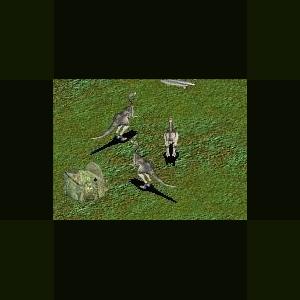About This File
Pelecanimimus was a small ornithomimosaur, at about 2-2.5 m long (6.5 - 8 ft). Its skull was unusually long and narrow, with a maximum length of about 4.5 times its maximum height. It was highly unusual among ornithomimosaurs in its large number of teeth: it had about 220 very small teeth in total, with 7 premaxillary, about 30 maxillary, and 75 in the dentary. The teeth were heterodont, showing two different basic forms. The teeth in the front of the upper jaw were broad and D-shaped in cross section, while those further back were blade-like, and on the whole the teeth in the upper jaw were larger than those in the lower. All of its teeth were unserrated, and had a constricted "waist" between the crown and the root.
Only one other ornithomimosaur is known to possess teeth, Harpymimus, which had far fewer (eleven total, and only in the lower jaw). The presence of such a large number of teeth in Pelecanimimus, coupled with a lack of interdental space, was interpreted by Perez-Moreno et al. as an adaptation for cutting and ripping, a "functional counterpart of the cutting edge of a beak," as well as an exaptation leading to the toothless cutting edge found in later ornithomimosaurs.
The arms and hands of Pelecanimimus were more typical of ornithomimosaurs, with the ulna and radius bones in the lower arm tightly adhered close to the hand, which were hook-like and had fingers of equal length.
Soft-tissue impressions preserved by the exceptional preservational environment of the La Hoyas lagerstätten revealed the presence of a small skin or keratin crest on the back of the head, and a gular pouch similar to the much larger pouches found in modern pelicans, from which Pelecanimimus took its name. Pelecanimimus might have been much like a modern day crane, wading out in lakes or ponds using its claws and teeth to capture fish and then storing them in its skin flap. Some parts of the impressions revealed a smooth, skin-like surface, initially interpreted as lacking any ornamentation or feathers. Pelecanimimus was also the first ornithomimosaur discovered with a preserved hyoid apparatus (specialized bones in the neck).
A cladistic analyses by Makovicky et al. (2005) indicated that Pelecanimimus is the basalmost member of the Ornithomimosauria, less derived even than Harpymimus. A study by Kobayashi and Lü in 2003 indicated that these two species formed a basal arrangement of steps leading towards the more advanced ornithomimids (see cladogram below). The discovery of Pelecanimimus has played an important and surprising role in understanding the evolution of the Ornithomimosauria. To quote Pérez-Moreno et al., "The phylogenetic hypothesis...supports an unexpected approach, involving exaptation, which might explain the evolutionary process towards the toothless condition in Ornithomimosauria. Until now, a progressive reduction in the number of teeth has been considered as the most likely explanation: the primitive tetanurine theropods have up to 80 teeth with tall blade-like crowns, and the primitive ornithomimosaurs have only a few small teeth. The phylogenetic hypothesis suggests an alternative evolutionary process based on a functional analysis of increasing numbers of teeth. A high number of teeth with enough interdental space and properly placed denticles (as in troodontids) would be an adaptation for cutting and ripping. On the other hand, an excessive number of teeth with no interdental space (as in Pelecanimimus) would be a functional counterpart of the cutting edge of a beak. Thus, increasing the number of teeth would be an adaptation for cutting and ripping, as long as the space between adjacent teeth was preserved...while it would have the effect of working as a beak if spaces were filled with more teeth. The adaption to a cut-and-rip function therefore becomes an exaptation with a slicing effect, eventually leading to the cutting edge seen in most ornithomimosaurs."



Recommended Comments
There are no comments to display.
Create an account or sign in to comment
You need to be a member in order to leave a comment
Create an account
Sign up for a new account in our community. It's easy!
Register a new accountSign in
Already have an account? Sign in here.
Sign In Now